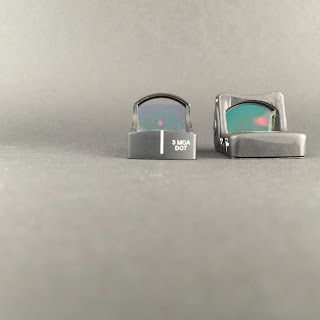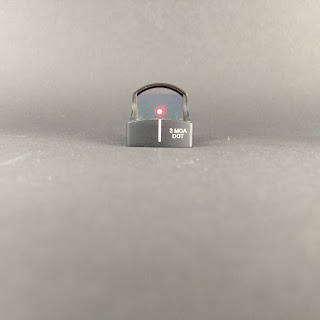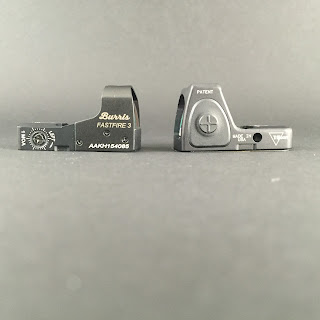Triggers, like most things, can be quite subjective. While trigger pull weights and reset distances can be objectively measured, but it often comes down to personal preference when it comes to feel. While I don't consider myself a trigger snob, I take a very critical look at triggers especially in my handguns. The trigger is a critical interface to firing the gun. It's that last thing that moves (hopefully) before the gun fires, and therefore can have a huge effect downrange. An 8 pound rifle can have a 2 pound trigger, but a 2 pound handgun may have an 8 pound trigger. Couple that with the fact that the rifle is stabilized by usually a minimum of 3 points of contact, and that we're more likely to have a handgun in a defensive situation than a long gun, and we can see why people get so wrapped around the axle about handgun triggers.
Anyone who says their Glock trigger is like a 1911 is either full of s**t or has never shot a 1911. It can't by nature of the design. The 1911 trigger slides back and forth, so it imparts zero vertical movement during it's rearward travel. The shoe length can be tailored to your trigger finger so that it breaks when your finger is at exactly 90 degrees. That means minimal horizontal movement as the shot breaks. The Glock trigger moves in an arc. Chances are, the break point is not at the point of the arc where vertical and horizontal movement are minimized. I think this is why some people hate the Glock trigger. It's not as short as a 1911, not as smooth as the double action of a Sig, and the trigger pulls are often inconsistent from shot to shot. Weight can be adjusted with springs for the most part, and pre and over-travel can also be tuned out or simply ignored since they occur before and after the gun actually fires.
There's a lot going on in the trigger stroke of a Glock. The lack of smoothness is the result of a bunch of metal and plastic parts sliding into and against each other. Ignoring the trigger safety, when you first pull the trigger, you can feel a slight bump as the trigger bar cam lobe hits the striker safety plunger. The trigger bar lifts the plunger as it slides under it. On Gen 4 Glocks, the trigger bar safety cam has a little bump on the side, which also rubs against the slide. The second more pronounced bump is when the rear of the trigger bar first contacts the connector. As you pull further, the end of the trigger bar slides down the connector rail until it drops far enough to clear the striker. During this last phase before firing, the trigger bar is now sliding against the safety plunger, connector rail, and down the striker hook. We must also take into account the trigger pivoting on its pin, the sides of the trigger rotating against the locking block and slide stop, and the trigger bar sliding against areas in the receiver. On top of that is the inconsistency due to three factors. The trigger is plastic and flexes slightly as you pull it. The trigger bar is doglegged around the magazine well, and also flexes and bows out a bit as it's pulled, pressing the side harder into the inside of the magazine well. Finally, the slide rails are loose for reliability which lets it move vertically. As the trigger bar slides down the striker, it actually pulls the striker and the slide down with it. Without a magazine in the gun, you can actually observe the rear of the slide drop slightly as the trigger is pulled. This drop increases the pull distance by a not insignificant margin. With a full magazine loaded in the gun, the pressure of the top round is enough to hold the slide in it's highest position, allowing the shortest trigger pull. As the spring pressure decreases as rounds are fired, the friction of the trigger bar and striker can overcome the magazine spring and start to allow the slide to drop down. I often wonder if this contributes to the "5th round flyer".
So, how do we address all these problems? The simple answer is to practice. Shooting and dryfire with eventually polish all the contact surfaces and 3k-5k rounds later, you should be quite proficient with the stock trigger. That said, why not take advantage of any gear or products that can make our lives easier. I'm NOT saying that gear is a shortcut to good practice, but it may help make that practice more efficient. At a minimum, if you have a Glock with a serrated trigger such as a G19, I'd replace it with a Gen3 G17 trigger for around $15. The smooth face is more comfortable than the serrated one and if you have a Gen4, the Gen3 trigger bar lacks a small bump on the striker block cam that smooths out the pull. Do a 25 cent trigger job while you're at it.
 |
| Glock 17 Gen3 Trigger |
 |
| Glock 17 Gen3 Trigger - Rest |
 |
| Glock 17 Gen3 Trigger - Pulled |
 |
| Glock 17 Gen3 Trigger |
If you truly feel that the trigger is limiting your speed and accuracy, there are two triggers that I've tried that work to SAFELY clean-up the Glock trigger. They are the Agency Arms Drop-In and the Apex Tactical Glock trigger with Ghost Evo 3.5 connector. I used both during Sage Dynamics Defensive Handgun Fundamentals course. On the first day I used the Agency.
The Agency trigger is damn impressive before you even shoot it. The trigger is beautifully machined out of aluminum, eliminating the flex of the factory plastic unit. The edges are rounded for comfort, but the face is flat with a small hook at the bottom. The trigger safety is wider than the factory one and is also flat and made of aluminum. The Agency logo is tastefully machined into the side. Black was out of stock but I'm perfectly happy with "Agency Grey".It comes with a pre-installed Gen3 trigger bar that's been polished. The rear where it contacts the striker has also been modified with a slight upward bend. The purpose of this is to release the striker at the rearmost position of the trigger stroke. The end result is a near elimination of over-travel. Pre travel is taken care of by cutting the slot in the trigger for the trigger bar so that the trigger can only move forward enough to clear the trigger safety. At this point, the cam for the striker block is just a hair away from touching the striker block, preserving the drop-safety. The final piece is a polished factory minus connector. All springs are left stock for reliability. The pull is excellent. There's no hint of the bump when the striker block is being raised. If you really try you can feel when the trigger bar hits the connector, but it's subtle enough to miss. The weight increases, stacking just a tough before the striker lets off. There is a hint of over travel but it's there for a reason. Remember how the slide can move down, effecting trigger pull distance? The test is to pull up on the slide when dry firing, then repeating with the slide pushed down. I've fitted some connectors where the striker wouldn't drop during the 2nd part of the test. The Agency trigger passes. Reset is textbook Glock. What's the cost for an excellent drop-in trigger like this? On top of the $150 msrp is the fact that the Agency moves the entire trigger press from start to finish about 1/4" further back in the trigger guard. The angle it creates makes me feel like I'm pulling "up" on the trigger as it breaks. Also the distance feels too close for me. I have the same problem with any AR-15 with a standard A2 grip. I really have to hook my finger in to break the shot. I wear size large Mechanix gloves and have long fingers from years of guitar playing. While the Glock's Gen4 backstraps would help increase the distance, they also make the grip too big for my palms. For smaller or medium sized hands the Agency trigger might be just the ticket, but the reduced trigger reach is not ideal for me. Also, the bottom of the trigger is open for the trigger safety. This creates 2 sharp "fangs" that dig into my trigger finger pad during extended firing. I had to consciously index my finger higher up on the trigger, but that might not be an option if you have big 'ol sausage fingers.
 |
| Agency Arms Trigger - "Fangs" |
 |
| Agency Arms Trigger - Rest |
 |
| Agency Arms Trigger - Pulled |
 |
| Agency Arms Trigger |
 |
Stock Trigger Bar - Top
Agency Trigger Bar - Bottom |
One the second day, I swapped the trigger with one from Apex Tactical and the Evo 3.5 connector from Ghost Inc that I fitted beforehand. Like the Agency trigger, the Apex is aluminum and flat faced with a small hook on the bottom. The aluminum trigger safety is narrower, but the bottom of the trigger is closed off. No sharp "fangs" here. I don't think it's nearly as nice to look at for what it's worth as the Agency. The trigger is wider than both the Agency and the stock plastic trigger, so it can't be used in a G42/G43. It reduces some pre-travel in the same manner as the Agency does, but not quite as much. It reduced over-travel a bit over stock, but it was much more noticeable than the Agency. More on that later. You can get the the Apex trigger with or without a Gen3 trigger bar installed. Save yourself the effort and get it with the trigger bar pre-installed. The first time used the Apex was actually on my G26. I re-used my Gen4 trigger bar which required drilling out a hole in the factory one. DO NOT USE a Gen4 trigger bar with the Apex! The Apex trigger sets the trigger bar a little further to the right than stock. This has two effects. First, the trigger bar is in a position to put more pressure on the inside of the magwell as it bows out during the trigger press. Second, the nub on the Gen4 trigger bar gets wedged hard enough into the slide to prevent the trigger from resetting! It also added what felt like 5 pounds to the weight and the feeling of dragging a brick across asphalt. With the Gen3 bar installed, it was fine. To nearly eliminate the over-travel, I fitted a Ghost Evo 3.5 connector. It features an over-travel stop that must be filed down until the striker fires. I filed and tested until the gun passed the dry-fire while pushing the slide down test. Then I filled it a little more to be safe. I also did a "25 cent trigger job", a step not required with the Agency. I kept the stock springs for this trigger as well. The pull is now similar to the Agency, albeit not quite as smooth, and with one critical difference. It's farther forward in the trigger guard than stock. For myself, the break point is spot on. Even with a willfully bad trigger press, I noticed my red dot doesn't bounce completely out of the window like with the stock or Agency trigger.
 |
| Apex Trigger |
 |
| Apex Trigger - Rest |
 |
| Apex Trigger - Pulled |
 |
| Apex Trigger - Wider than stock |
So what's the verdict? Which one allowed me to drop my split times and cut ragged holes in my targets? Well, my performance was about the same on both training days with both triggers which was not high enough to earn the Red Sage patch. I can't blame the trigger or any of my equipment for that. It's proof that practice will always trump gear, and Lord knows I need to practice. The Apex kit with trigger bar is $50 cheaper than the Agency, but I had to spend $45 on the Ghost connector to get it comparable. Add in the time of fitting the connector and the price difference is a wash. Both are excellent choices, but I think the decision comes down to hand size. I put the Apex in my EDC Glock 19. It just works better for my hand size and finger length. I put the Agency in my home defense Glock 19. (31 round mag, weapon light, and suppressor) My wife is more likely to use that gun and she preferred the shorter reach of the Agency. For now, all my future Glocks will wear Apex triggers. Now if Agency ever comes out with a longer reach version...
-Carry On
Update:
So after putting another 300 rounds through the Apex, a few more issues have surfaced. One, you can't pull the trigger after it's reset if the gun is slightly out of battery. The trigger safety hook is large enough that you can't really overcome it. So instead of the dreaded "click", you simply get no movement in the trigger. Second, I've been placing my finger higher on the trigger as I've found I shoot better that way, but sometimes, I don't get enough of the trigger safety and it hangs up. It never prevents me from pulling the trigger, but it is annoying. Also, while I at first liked the longer reach, now that I've gotten more trigger time, I think it's a little too long. Finally, the front edges of the Apex trigger aren't as rounded as the Agency and just doesn't feel as nice. So, I sacrificed a stock Gen3 trigger and relieved it of it's trigger bar, which I gave a nice polish. I swapped the Gen3 trigger bar for the modified one in the Agency and installed it in my EDC G19. I had to fit the trigger stop on the Ghost Evo 3.5 connector but the results are terrific. The Agency trigger now starts in the same place as before, but breaks closer to where the factory trigger does with a "minus" connector. There's just enough over-travel to pass the push-down-on the -slide-and dryfire test. I've put 200 rounds downrange and I'm pretty happy with it so far. I'm pretty close to putting this setup on all my other Glocks.
 |
| Agency Trigger, Stock Bar, Ghost Evo 3.5 Connector - Rest |
 |
| Agency Trigger, Stock Bar, Ghost Evo 3.5 Connector - Pulled |



























































